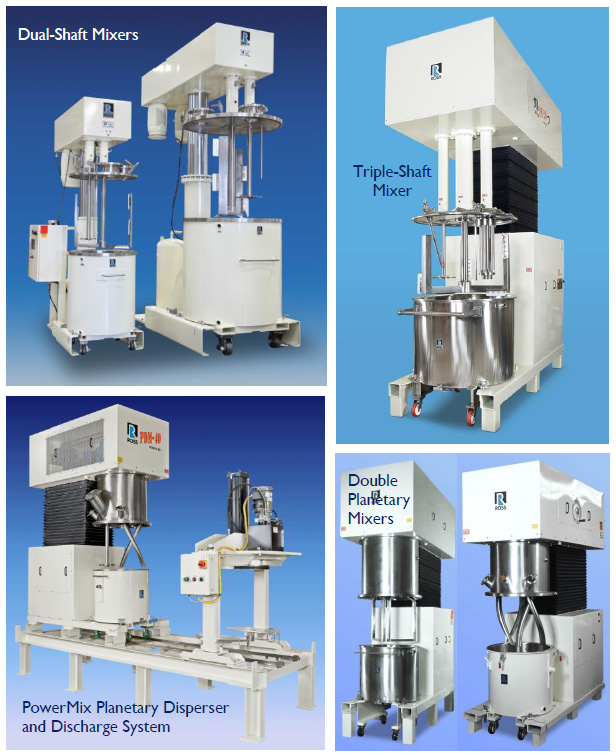Tech Report
Recommended Mixing Equipment for Lubricant Pastes

Application Summary
Different types of lubricants are formulated according to their intended application, environment and performance. Solid lubricants, thickeners and/or additives are added to a base oil in order to achieve the desired rheology, stability, wear resistance and other characteristics. But whatever the composition, proper agitation and temperature control during mixing are critical factors in optimizing finished product quality.
The mixing technologies utilized in the production of lubricants and greases vary from one formulation to another. Mixer selection is based more on viscosity profile and shear requirement than solids content.
Ross Multi-Shaft Mixers and Planetary Mixers
Ross Multi-Shaft Mixers are well-proven equipment in the preparation of paste-like lubricants and greases. Equipped with two or more independently-driven agitators working in tandem, Multi-Shaft Mixers deliver a robust combination of high shear agitation and laminar bulk flow ideal for a wide range of thixotropic fluids up to several hundred thousand centipoise.
The most economical design is the Dual-Shaft Mixer which features a low-speed anchor and a high-speed saw-tooth disperser blade. A typical mixing procedure starts with charging of the base fluid which may consist of mineral oil, vegetable oil, silicone oil, other synthetic liquids (polyalphaolefins, esters, fluorocarbons, etc.) or a mixture of these substances. Liquid additives may also be added to the vessel at this stage. Solid lubricants along with thickeners and additives such as fumed silica, clay, carbon black and rubber powders are then mixed into the batch in increments. Some of these powders are best introduced sub-surface using a modified rotor/stator assembly to prevent excessive dusting and persistent floating. In these cases, a Triple-Shaft Mixer configuration is recommended.
As the batch increases in volume and viscosity, adequate material turnover and precise temperature control in the Multi-Shaft Mixer facilitates fast dissolution or dispersion of the solid ingredients without overheating and degrading the product. Scrapers attached to the anchor agitator help optimize heat transfer across the jacketed sidewalls and vessel bottom. Vacuum is typically applied in the later stages of mixing to produce a smooth, air-free and homogenous paste.
Finished product that is too slow to discharge by gravity can be pressed out of the vessel by a platen-style Discharge System. This allows for efficient transfer of viscous and sticky materials with minimal waste and clean-up. (Note: After being batched in a Multi-Shaft Mixer, certain greases and lubricants are pumped through a Ross Inline Ultra-High Shear Mixer for further particle size reduction, as necessary.)
Multi-Shaft Mixers easily adapt to changes in product rheology because the agitators can be engaged in any combination and at any speed for any interval during the mixing cycle. But lubricant formulations that undergo very high viscosity peaks (above 1 million cP) are better prepared in planetary-style mixers featuring blades that rotate on their respective axes while revolving around the mix vessel. In other words, the agitators continually advance into the batch and contact fresh product all the time.
Combining slow-speed planetary agitation with an orbiting high-speed disperser, the Ross PowerMix Planetary Disperser quickly incorporates large amounts of solids into a thick liquid base. Independent control of each agitator enables the operator to fine-tune flow patterns and shear rates as needed. The classic Double Planetary Mixer, on the other hand, is ideal for formulations which start out with melting a semi-solid or highly viscous paste. Moving at relatively low speeds, the identical planetary stirrers impart increasing levels of shear as the batch gains considerable viscosity. Testing is recommended to confirm the best mixing strategy and equipment for a particular lubricant product.
Other applications of Ross Multi-Shaft Mixers and Planetary Mixers:
- Battery Slurries
- Ceramic Dispersions
- Conductive Inks
- Cosmetic Creams
- Dental Composites
- Energetics
- Filled Epoxies
- Fuel Cell Pastes
- Gum Dispersions
- Lubricants
- Medical Gels
- Metal Suspensions
- Molding Compounds
- Pharmaceutical Pastes
- Plastisols
- RTV Sealants
- Silicones
- Solder Pastes
- Syntactic Foams
- Thermal Greases
- Thick Film Inks
- Viscous Foods
